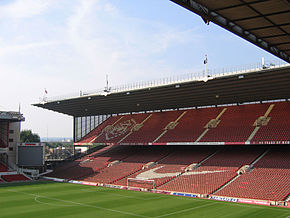 Global Information
Global InformationArsenal Stadium information
Highbury – the "Home of Football"[1][2] | |
 The North Bank stand of the stadium in 2005, a year prior to demolition | |
 | |
| Full name | Arsenal Stadium, Highbury Stadium |
|---|---|
| Location | Highbury, London, England |
| Coordinates | 51°33′28″N 0°6′10″W / 51.55778°N 0.10278°W |
| Owner | Arsenal Holdings plc |
| Operator | Arsenal |
| Capacity | 38,419 (at closure), 73,000 (peak) |
| Field size | 109×73 yds / 100×67 m[3] |
| Construction | |
| Opened | 6 September 1913 |
| Renovated | 1932–1936, 1992–1993 |
| Closed | 7 May 2006 |
| Demolished | 2006; redeveloped as housing |
| Construction cost | £125,000 (1913 original) adjusted for inflation: £13.1m £175,000 (1930s redevelopment) adjusted for inflation: £11.8m £22.5m (1990s redevelopment) adjusted for inflation: £49.5m |
| Architect | Archibald Leitch (1913 original) C. W. Ferrier and W. Binnie (1930s redevelopment) LOBB partnership (North Bank) |
| Tenants | |
| Arsenal F.C. (1913–2006) | |
Arsenal Stadium was a football stadium in Highbury, London, which was the home of Arsenal Football Club between 6 September 1913 and 7 May 2006. It was popularly known as "Highbury" due to its location and was given the affectionate nickname of the "Home of Football".[1]
It was originally built in 1913 on the site of a local college's recreation ground and was significantly redeveloped twice. The first reconstruction came in the 1930s from which the Art Deco East and West Stands date. There was a second development; the first phase was completed in 1989 which added executive boxes to the Clock End, and afterwards in 1993 a new North Bank Stand was constructed, both following the recommendations of the Taylor Report which replaced the terraces to make the stadium an all-seater with four stands.However, further attempts to expand the stadium were blocked by the community resulting in a reduction in capacity and matchday revenue. This led to Arsenal opting to build a new stadium, the Emirates Stadium. After the club moved to their new stadium upon the conclusion of the 2005–06 season, Highbury was redeveloped as a residential development known as Highbury Square, with the Clock End and North Bank stands being demolished; parts of the East and West Stands remained and were incorporated into the new development due to their listed status.
The stadium also hosted international matches – both for England and in the 1948 Summer Olympics – and FA Cup semi-finals, as well as boxing, baseball and cricket matches.[4] Its presence also led to the local London Underground station being renamed to Arsenal in 1932, making it the only station on the Underground network to be named after a football club.
In addition to its architecture, the stadium was known for its small but immaculate pitch[5] and for the clock which had been positioned in the southern side of the ground since its introduction in 1930.[6]
- ^ a b "Old Highbury". Flickr. 9 June 2005. Retrieved 23 January 2007.
- ^ "Arsenal property deals send profits to record high". BBC News. 24 September 2010.
- ^ "Key Facts". Arsenal F.C. Retrieved 23 January 2007.
- ^ 1948 Summer Olympics official report. pp. 45–6.
- ^ "Emirates Stadium: New goal for the Gunners". The Independent. London. 4 December 2006. Archived from the original on 27 February 2009.
- ^ "The Arsenal Clock | Arsenal's Heritage | History". Arsenal F.C. 1 July 2008.